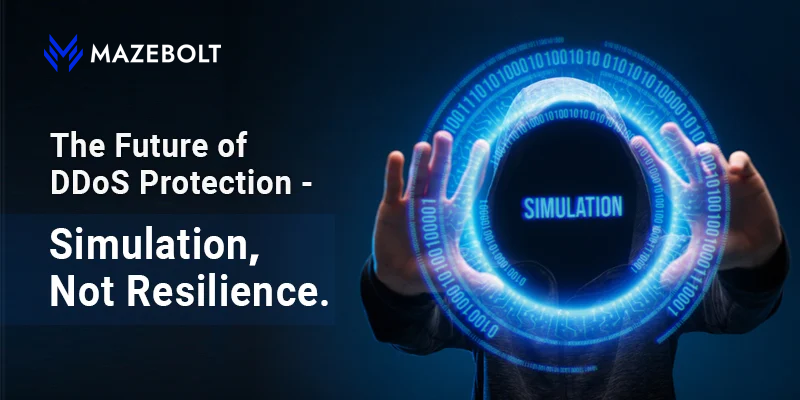Existing DDoS Protection Shortcomings
As the word ‘Resilient’ indicates, DDoS mitigation solutions do not prepare for attacks ahead of time. They adapt to and recover from DDoS attacks after they have been hit. Most enterprises trust their DDoS protection in the hands of DDoS mitigation vendors who offer resilient DDoS mitigation solutions. Still, these resilient DDoS solutions do not have a way to detect DDoS vulnerabilities before the network is attacked. They act after the attack comes in, and then they `resiliently` mitigate attacks – meaning organizations get hit, go down, but later recover. Depending on the mitigation solution’s capabilities, SLAs signed, and so forth, the resiliency is determined, that is, how long it takes for services to be restored. This number can be anywhere in the range of 30 seconds up to a few days.
The inherent shortcomings in mitigation solutions are apparent and can be seen in the DDoS attacks that continue to cause severe damage to businesses worldwide. In May 2021, a large-scale DDoS attack was the cause several sections of Belgium’s internet going down. Several organizations in Belgium, including the government and parliament, were affected by this DDoS attack that overwhelmed them with bad traffic.
Last year, Amazon Web Services (AWS) was hit by a massive attack. This 2.3 terabits per second attack lasted for over three full days. There were several DDoS attacks in the month of April 2021, and we were able to create an overview report. All, if not most, of the attacked enterprises, had mitigation solutions. Despite this, massive attacks continue to take businesses, enterprises, governments, and sometimes entire countries offline. For many such companies, disruption of information technology (IT) services can directly correlate to lost revenues, and here is the list of the top 4 industries impacted by DDoS attacks. Finally, customer expectations have increased, and there is an expectation of `always-on connectivity, which means that businesses cannot afford any downtime.
Critical Reasons for Damaging DDoS Attacks Despite Mitigation Solutions
- Mitigation solutions are robust but need to be continuously monitored and configured. However, in today’s climate, it is impossible because network vulnerabilities frequently change as new services and applications are added. As a result, outdated configurations leave systems open to new DDoS vulnerabilities.
- DDoS attackers are insidious, and there have been several attacks over the years that are low and slow, i.e., the attack focuses on loading the service. Still, it does not trigger the mitigation system thresholds, creating a set of different attacks that slow services down, take a long time to detect, and cause the response team’s focus to be distracted.
- DDoS attackers are also launching multi-vector attacks that use a complex mix of different attack vectors to a variety of targets, making it much more complicated for mitigation systems and services to focus on what’s going on and what to block first. This strategy successfully achieves more extended downtime before attack detection and mitigation. Here is an interesting factsheet on how Hackers continuously study DDoS protection limitations and launch multi-vector attacks.
- A long time to mitigation stems from the realization that, in many cases, DDoS protection systems have an intrinsic minimum response time required to detect malicious DDoS traffic and that mitigating the attack requires even more time. Hackers abuse this deficiency by changing attack tactics (vectors and target combinations) in a time frame shorter than the protection system’s response time, avoiding triggering the mitigation system. A series of such fast attacks will easily cause damage to the target network services.
So, is it possible to prevent these attacks? Is there a more efficient and innovative way to stay on top of DDoS attacks?
Mitigation solutions can only prevent or stop all DDoS attacks with continuous configuration. By themselves, they are only able to detect configuration gaps and mitigate attacks after the attack has already taken the network down. The choice for enterprises is to decide if they want resilience to mitigate attacks or would prefer to ensure those network vulnerabilities are identified and closed on an ongoing basis.
Introducing MazeBolt’s RADAR™ technology
RADAR™, MazeBolt’s new patented technology solution, is the only 24/7 automatic DDoS attack simulator on a live environment with ZERO downtime/ disruption. It automatically detects, analyses, and prioritizes the remediation of DDoS vulnerabilities in any mitigation system. We are raising the efficiency of your Mitigation solution and delivering the ultimate DDoS protection.
RADAR™ Simulates DDoS attacks with no downtime!
- To effectively block complex and intermittently changing threats, the new RADAR™ technology helps enterprises continuously validate and remediate the entire DDoS protection posture 24/7. It thereby smartly fixes known areas of weaknesses proactively, as there is no time to do this when an attack starts.
- RADAR™ breaks complex attacks into individual attack vectors to ensure protection automatically against mixed vector attacks. Mitigation alone is not always possible, but simulation can be done.
- RADAR™ starts at a low rate and increases attack simulations to identify new potential targets that are susceptible to attacks from external attackers.
- It monitors all simulated traffic downstream from the DDoS mitigation device or scrubbing center.
- RADAR™, by mirroring ports during simulation, detects attack leakages instantaneously and remediates them on the go.
And finally, RADAR™ continuously maintains a complete DDoS mitigation posture without causing any disruptions or downtime.
https://info.mazebolt.com/hubfs/datasheet_Maximize%20DDoS_082022%20(2).pdf
About MazeBolt Technology:
Israel-based MazeBolt is an innovation leader in cybersecurity with over two decades of experience in pioneering DDoS protection solutions. The company’s new flagship product, RADAR™, is a patented technology. With zero downtime, it offers DDoS protection through automated DDoS simulations on live production. It works in conjunction with any mitigation solution installed. Its unique capabilities have ensured business continuity and the entire DDoS security posture for enterprises worldwide, including Fortune 1000 & NASDAQ-listed companies.







